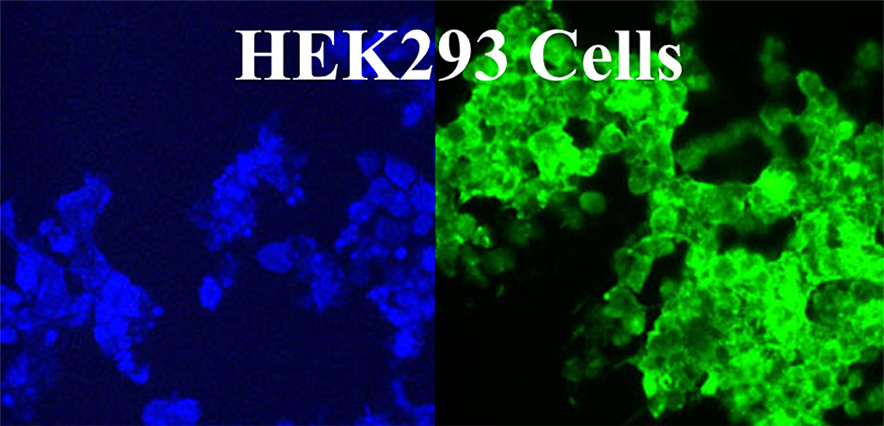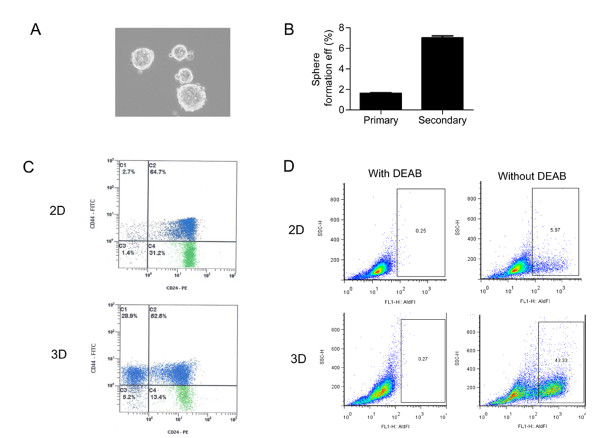The most comprehensive introduction of HEK293 collections --
Ubigene

HEK293 cell line is one of the most frequently used cell lines. Its
application in scientific research is second to HeLa, and its industrial
application is second to CHO. However, there is a huge family of HEK293, and
he application differences between different derived strains? In this
article, we will give introduction of HEK293 series cell lines and their
different applications in gene editing.
Introduction of HEK293 and its derived strains
HEK293 (human embryonic kidney 293), is derived from human embryonic kidney
cells. Due to the integration of about 4.35 kb adenovirus genome segment on
chromosome 19, its cell cycle, phenotype, karyotype changed, and became
immortalized. It is widely used to produce proteins, vaccines, anti-cancer
reagents, recombinant adenovirus coating, etc.
So far, according to different research and production needs, many subtypes
and derived cell lines of HEK293 cells have been established (Figure 1). In this chapter, 293T, 293H, 293F and 293S are mainly introduced.

Figure 1. Family tree of HEK293
cell line
293T cell line
HEK293 cell line stably transfected with SV40 largeT antigen and derived as
293T cell line. 293T cell line is as easy to be transfected as HEK293. The
efficiency of transfection with calcium phosphate, PEI or liposome can reach
more than 90% [1]. The SV40 largeT antigen can achieve the amplification of foreign
expression vector, and finally increase the expression amount of target
gene. In addition to gene expression and protein production, 293T cells are
often used for packaging lentivirus, retrovirus and adenovirus.
293H cell line
This cell line is also derived from HEK293
cell line, which can grow rapidly in serum-free culture
system with high transfection efficiency and high protein expression
performance. This cell line is different from HEK293 and 293T
cell lines. It firmly attaches to the plate and can be used not only for plaque detection, but also for production
of recombinant proteins. For example, the recombinant protein VIIIFc fusion protein (rfviifc), a
long-acting coagulation factor approved for the treatment of Hemophilia A, is
currently in short supply on a regular basis and in violation of production
quality, indicating that it is still difficult to manufacture rFVIII. rFVIII
is a large and multi-domain glycoprotein with
significant post-translational modification. Therefore, a key point for McCue,
Justin et al. [2] in optimizing the production process of
rfviifc is to use a human cell line without adding any
ingredients from humans or animals. This shows that 293H cell line has
biochemical characteristics conducive to the expression of recombinant
protein, such as easy transfection, efficient human protein translation
processing and production.
293F cell line
293F cell line is a wild type 293 cell line that can grow rapidly in
serum-free culture system, and can express protein efficiently. F refers to
Fast-growth. 293F transfected with pCMVSPORT6TAg.Neo plasmid and derived to
293FT. It is usually used in the production of lentivirus. 293FTM cell line
were obtained from Flp-InTM T-RExTM 293 cell line by introducing
the ecotropic reporter plasmid and the MAPPIT (mammalian protein-protein
interaction trap) reporter plasmid, and this cell line is commonly used for
protein interaction screening.
293S cell line
293S cell line is a suspension cell line, and S refers to Suspension. This cell line can tolerate low Ca2+culture system. 293SG cell line is derived from 293S cell line that induced by methanesulfonic
acid, screened by ricin, and introduced with pcDNA6/TR
plasmid. 293SG is commonly used for the expression of
glycosylated proteins. 293SGGD cell line were obtained
by transferring pcDNA3.1-zeo-STendoT plasmid into 293SG
cell line, and it is mainly used in
glycosylation engineering research.
Application of 293 and 293T cell lines in gene editing
According to the above introduction, you can see that 293 and 293T cells have many basic
applications in gene editing. Here we have found some cases of 293 gene
editing.
1. Bekier, Michael E. et al. [3] used CRISPR/Cas9 technology to
knockout two types of Golgi stacking proteins GRASP55, GRASP65 in HeLa and HEK293 cell lines. The
characterization of these cell lines showed that the single knockout of
GRASP55 or GRASP65 damaged the accumulation of Golgi cisternae, while the
double knockout of the two GRASP proteins would decompose the entire Golgi
apparatus structure. The decomposition of Golgi apparatus not only accelerates
protein transport, but also impairs the accurate glycosylation of proteins and
lipids on the cell surface. These KO cell lines provide useful tools for
studying the mechanism and biological significance of Golgi structure
formation, and may be used to study the pathology of Golgi defects, such as
Alzheimer's disease, congenital glycosylation disorder, foot and mouth
disease, reoxygenation injury, and a variety of cancers.
2. Yin et al. [4], in order to obtain RPA12
shRNA expressing HeLa cell line and mCherry
RPA12 expressing HeLa cell line, respectively transfected 293T
cells with lentiviral plasmid carrying RPA12
shRNA or mCherry-RPA12 and packaging plasmids pH1 and pH2, and then collected
lentivirus particles to transduce HeLa cell line. In
addition, Debeb, Bisrat G. et al.[5] found that 293T cells can
be easily cultured and passaged as spheres under the condition of
serum-free stem cell culture system. Compared
with monolayer cells, cells cultured as three-dimensional spheres (3D) in
vitro showed higher ALDH1 and CD44+/CD24- populations.
In addition, 3D spheres generated from 293T cells increased the expression of
mesenchymal genes, and microRNAs related to self-renewal and transfer were
significantly reduced in 3D spheres. Finally, it is believed that the 3D
sphere 293T cells show cancer stem cell phenotype, which is an
important research tool for studying the molecular and biological mechanisms
of cancer stem cells and testing and developing new targets for cancer
treatment.

Figure 2. 293T cells form spheres in suspension culture that exhibit cancer stem cell
phenotype.
A, B) Sphere formation in 293T cells seeded in self renewal promoting
suspension culture conditions. Passage of 293T spheres gives rise to higher
proportion of secondary spheres. C) Flow cytometric analysis of expression of
CD24 and CD44 in 293T cells. Cells were cultured under adherent (2D) or
tumor-initiating cells enrichment condition (3D). There is an increase of
CD44+/CD24- population in cells cultured in 3D vs. 2D
culture conditions. D) Flow cytometric analysis of ALDH activity showed that
the 3D culture condition enriches for ALDH-positive cells compared to the 2D
culture of 293T cells.
How to choose 293 and 293T for your research?
HEK293 and 293T cells are the two most commonly used cell lines in the 293
family. Because they have many similarities in gene and phenotype, people
often get entangled when choose them for research. So how to choose the best
one for your subsequent experiments?
By analyzing the genome sequencing result of the offspring cell lines derived
from HEK293, it was found that compared with the parent HEK293, these cell
lines’ chromosomes were more unstable, and the copy number increased or lost at
multiple locations in the genome. According to the actual cases of Ubigene, 293T is prone to have compound
heterozygote during gene editing, which is difficult to validate the exact genotype. Therefore, we believe that HEK293
cell line is more suitable for gene editing experiments such as KO, KI or point
mutation. In 293T cell line, due to the transfection of the SV40T
antigen, the plasmid containing SV40ori could be significantly amplified
in the cell line, thus promoting gene expression. In addition, after
transfected with SV40 large T antigen, the cell proliferation was
significantly improved compared with HEK293, so 293T
cell line is more suitable for plasmid transfection, virus packaging and other expressing experiments.
In a word, the 293 series of cell lines have been transformed and
optimized for a long time, and have been widely used in many fields.
Ubigene has rich experience in gene editing and cell modeling for 293 and
293T , and has 1000+ in-stock KO HEK293 cell lines, covering more than 20
signal pathways, 11 drug targets and most cancer genes. As low as $1780,
get a homozygous KO clone in one week, speed up your experimental
research. Click here to explore our KO cell bank>>
In addition, Ubigene provides customized services for cell engineering,
eg. gene editing (knockout and knockin), and stable cell line generation
(overexpression/interference). Ubigene also offer plasmid construction and
virus packaging services. Contact us for more service details!
Reference
[1] Lin, Yao-Cheng, et al. "Genome dynamics of the human embryonic kidney
293 lineage in response to cell biology manipulations." Nature communications 5.1 (2014): 1-12.
[2] McCue, Justin, et al. "Manufacturing process used to produce
long-acting recombinant factor VIII Fc fusion
protein." Biologicals 43.4 (2015): 213-219.
[3] Bekier, Michael E., et al. "Knockout of the Golgi stacking proteins
GRASP55 and GRASP65 impairs Golgi structure and function." Molecular biology of the cell 28.21 (2017): 2833-2842.
[4] Yin, Xiaomei, et al. "RNA polymerase I subunit 12 plays opposite
roles in cell proliferation and migration." Biochemical and Biophysical Research Communications 560 (2021): 112-118.
[5] Debeb, Bisrat G., et al. "Characterizing cancer cells with cancer
stem cell-like features in 293T human embryonic kidney cells." Molecular cancer 9.1 (2010): 1-12.
[6] Malm M, Saghaleyni R, Lundqvist M, et al. Evolution from adherent to
suspension: systems biology of HEK293 cell line development[J]. Scientific
reports, 2020, 10(1): 1-15.








